How to Find Amazon FBA Wholesale Suppliers
Download Amazon Seller Guide
This guide will help you get started, understand the basics of Amazon selling, and explain in simple words how it all works.

Many Amazon sellers who want to grow their online arbitrage or mini-wholesale business to large-scale operations have difficulties finding suppliers for profitable products. This is because a lot of brands they want to work with may already have an established distributor network and are reluctant to work with Amazon sellers who don't have physical stores.
This post will guide you through various methods for finding reputable Amazon FBA wholesale suppliers. From finding local brands to competitor research, we'll explore a range of strategies to help you choose the best suppliers.
How Does Amazon Wholesale Work?
.webp)
Related: How to Buy and Sell Amazon Return Pallets in 2024
Amazon Wholesale: How to Sell Wholesale on Amazon in 2024
How To Negotiate Prices With Amazon FBA Wholesale Suppliers
In the Amazon wholesale business model, sellers purchase products in bulk from brands or distributors at a low wholesale price and then resell them at a higher retail price on Amazon, keeping the profit margin.
Your main tasks in this business model are to find a reliable supplier (either a brand or distributor) and select their most popular and profitable products to sell on Amazon. This approach is known as direct sourcing.
With direct sourcing, you start by obtaining a list of products from the supplier. Next, you identify these products on Amazon, selecting those that have good sales volumes and high-profit margins. Finally, you list and sell these products, making a profit from the difference between your purchase price and the selling price.
Steps to Amazon wholesale
.webp)
Related: 12 Ways to Find Wholesale Suppliers for Amazon FBA
How to Find Amazon FBA Wholesale Suppliers
How to Buy Wholesale to Sell on Amazon?
Step 1. Get a reseller’s permit
Before you can start your wholesale business on Amazon, you need to obtain a reseller’s permit. This permit allows you to purchase products in bulk without paying sales tax, which you will collect from customers when you resell the items.
Step 2. Choose a product category
Select a specific category and subcategories of products to focus on. Consider your interests, find a balance between category popularity and competition (the most popular categories are always highly competitive), and potential for profit. A well-defined niche helps you focus your efforts. Consider factors like demand and profitability when choosing your product category.
Step 3. Choose a potential supplier
Identify potential suppliers who offer the products within your chosen niche. Suppliers can be brands or distributors. Look for suppliers with a good reputation and a broad range of products.
Tip. You can automate brand research with Brand Analyzer by Seller Assistant to identify if a brand is resale-friendly. Brand Analyzer helps efficiently identify if the brand meets your revenue targets and other selling criteria and whether it’s worth reselling on Amazon.
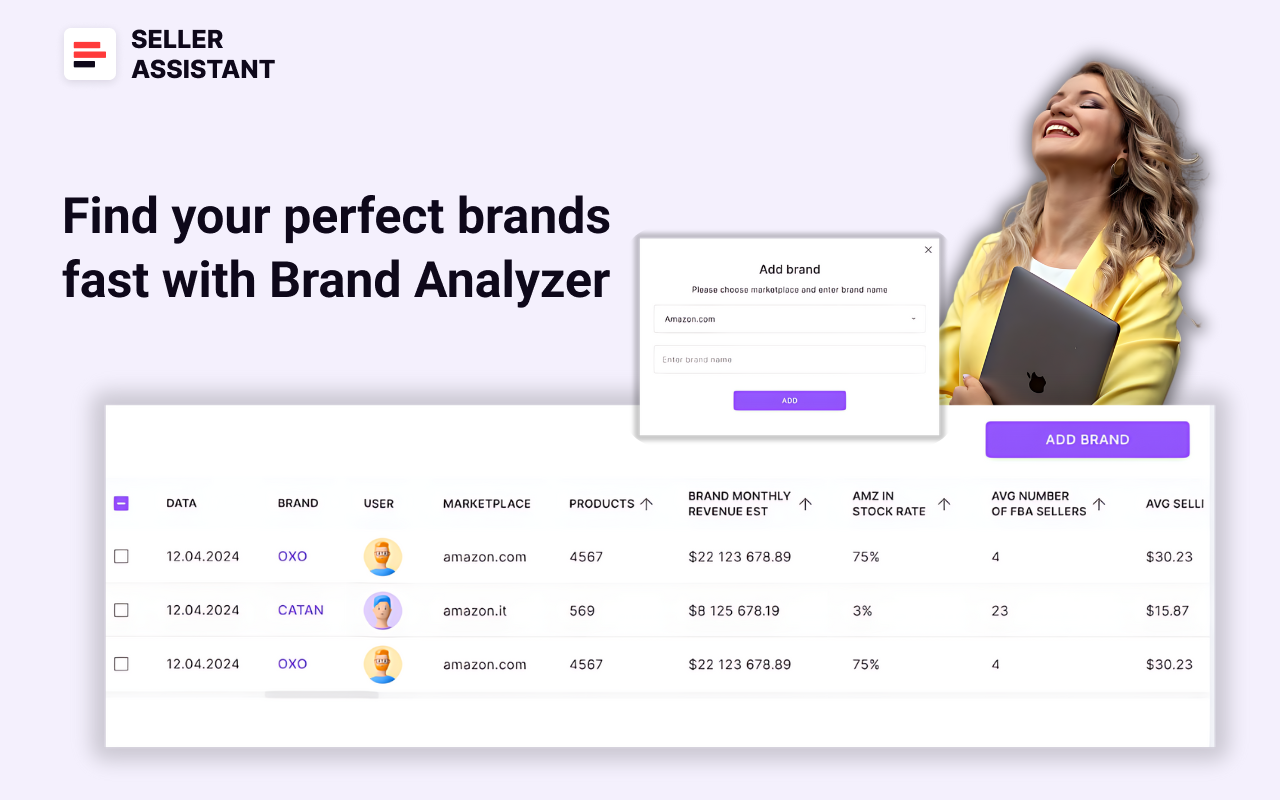
Brand Analyzer allows to estimate how big the brand is and how many products it offers, how much money you can potentially make if you sell this brand, how intense is the competition from Amazon and other sellers, average Buy Box price per product, and review and rating quality. To analyze a brand, type in the brand name you want to research. Once the analysis is complete, review the data.
Step 4. Vet the suppliers
Thoroughly verify your potential suppliers to ensure they are reliable and offer quality products. Check their reviews, request references, and verify their business credentials to avoid any future issues.
Step 5. Contact the supplier
Reach out to your chosen suppliers through phone, email, or their website. Introduce yourself and your business, and express your interest in opening a wholesale account with them.
Step 6. Send an application
Complete and submit the supplier’s application form typically available on their website. This usually requires providing business information, such as your reseller’s permit, business license, and contact details. Shortly describe who you are and what you want.
Step 7. Get approval and open wholesale account
Once your application is approved, you can open a wholesale account with the supplier. This account allows you to purchase products at wholesale prices.
Step 8. Get inventory list with prices
Request an inventory list from your supplier that includes product details and wholesale prices. This list is essential to find out the products that will be in demand on Amazon and will be profitable.
Step 9. Research products
When you get a price list from the supplier, you must find profitable deals to resell on Amazon. Deals are products that sell well, bring you the profit and ROI you expect to get (each seller has their own requirements to profitability), and don’t have any restrictions or flags (like meltable products you can’t sell with FBA all year round or heavy and bulky requiring extra logistics costs and hassle). You must also check your eligibility to sell the products.
Related: How to Choose Wholesale Products to Sell on Amazon?
Online Arbitrage vs Wholesale on Amazon. What is the difference?
How to Master Wholesale Distribution for Amazon
Since you may have hundreds of products on the list, this may be a challenging task, and the best solution is to use product sourcing software to automatically identify profitable deals.
Tip. One of the best product sourcing tools, Seller Assistant's Price List Analyzer, helps automate product research. This tool automates research of supplier price lists and helps identify the most profitable deals to sell on Amazon. It automatically matches your supplier products to Amazon, calculates profitability for each product, and shows other essential metrics. You can filter the results by any metric you need, and see which deals are profitable, and which have hidden risks or alerts.
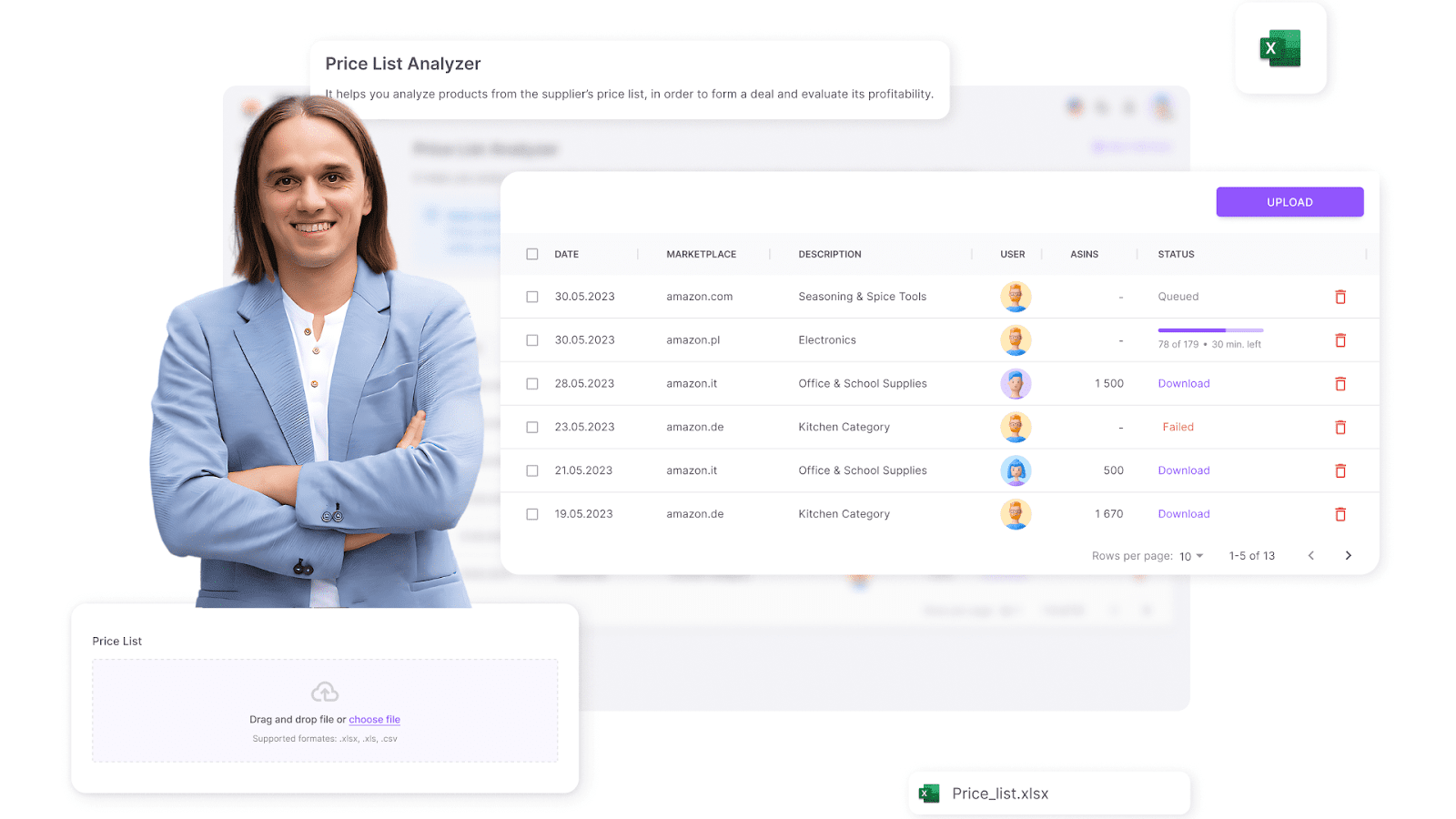
Related: Amazon FBA for Beginners
Then, confirm if you can sell the products on Amazon with the Bulk Restrictions Checker. Upload the product list to Bulk Restrictions Checker and download a report with the checkup results. If you can sell a product on Amazon, it will be marked with the green open lock. If a product or brand is restricted, it will be marked with the red closed lock. If you can’t sell it on your Amazon seller account, it will be marked with the red closed lock with an exclamation mark.

Step 10. Negotiate with the supplier
Engage in negotiations with your supplier to get the best possible prices. Aim for mutually beneficial terms, build a long-term relationship for better deals. Order in larger quantities to secure bigger discounts. Commit to recurring orders for more significant savings. Maintain consistent orders and build strong relationships for ongoing discounts.
Step 11. Pay for your order
Once you have negotiated the terms, pay for your order. Most suppliers accept various payment methods, including the ACH (Automated Clearing House) transfers, wire transfers, and credit cards.
Step 12. Prep and ship inventory
Use Fulfillment by Amazon (FBA) where Amazon takes care of fulfillment and customer service for a fee or Fulfillment by Merchant (FBM) where the same is handled by a third-party logistics partner, depending on what is cheaper. If using FBA, prepare your inventory according to Amazon’s requirements and ship it to Amazon’s fulfillment centers. Ensure your products are properly labeled and packaged to avoid any issues during the fulfillment process.
Note. Seller Assistant is a comprehensive product-sourcing software that helps Amazon sellers quickly find high-profit deals. It combines three extensions: Seller Assistant Browser Extension, and IP-Alert Chrome Extension by Seller Assistant, and VPN by Seller Assistant, Amazon seller tools: Price List Analyzer, Brand Analyzer, Seller Spy, Bulk Restrictions Checker, and API integrations, and features: Side Panel View, FBM&FBA Profit Calculator, Quick View, ASIN Grabber, UPC/EAN to ASIN converter, Stock Checker, IP Alert, and Restrictions Checker.
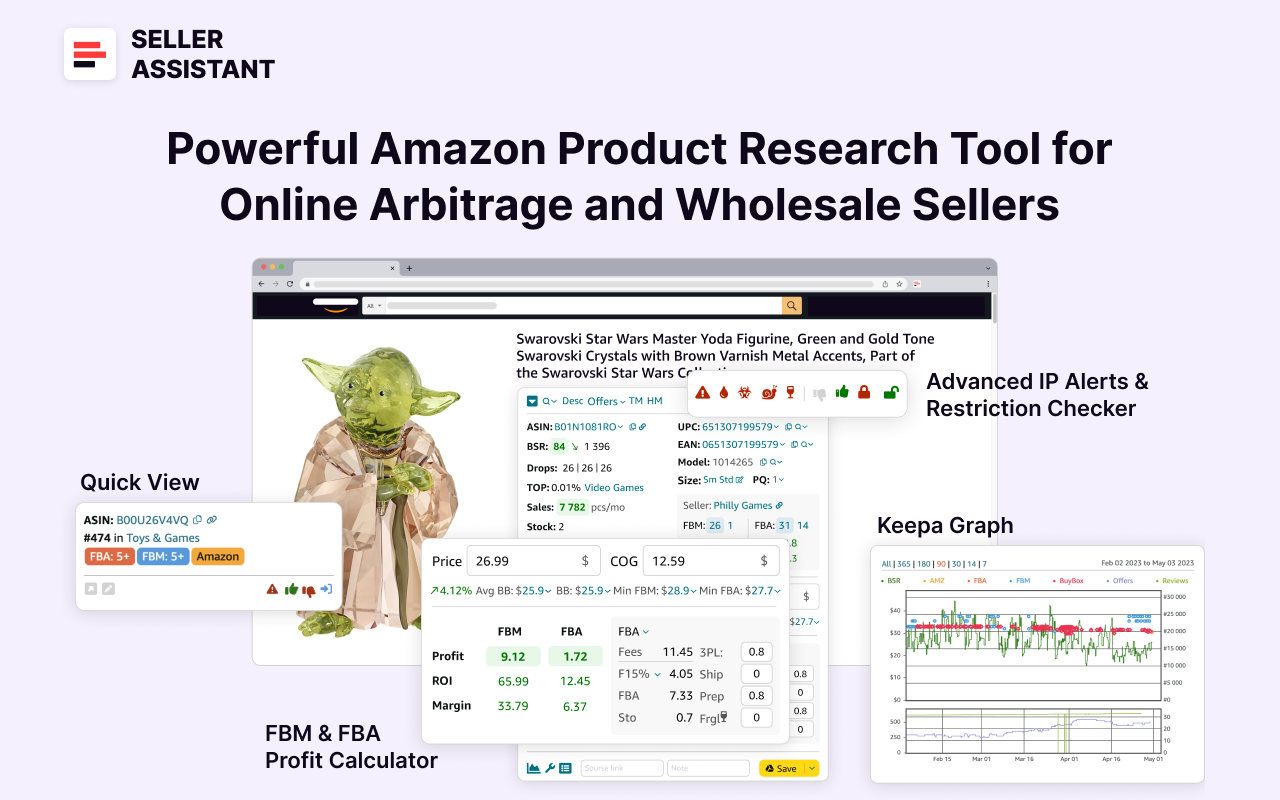
Related: Amazon Wholesale: All You Need To Know
How to Negotiate Prices With Amazon FBA Wholesale Suppliers
What Amazon Wholesale Suppliers to Buy from?
As a wholesaler, you must select a supplier depending on your budget and their Minimum Order Quantities (MOQ). For example, if you are just starting out and have $5,000 to 10,000 to spend on inventory, approaching huge brands like Apple or Adidas will be a waste of time. Below we discuss the types of wholesale suppliers you can buy from.
Types of Wholesale Suppliers
.webp)
Big Brands / Manufacturers
Big brands and manufacturers are suppliers who produce goods on a large scale and often have well-established reputations and brand recognition.
- Good for
- Established sellers who already have a solid business foundation and can meet high minimum order quantities;
- Sellers with larger budgets to invest in bulk purchases and the ability to manage higher upfront costs.
- Advantages
- Products from big brands often come with built-in customer trust and recognition;
- You don’t need to invest much in advertising; popular brands typically promote their product themselves.
- Challenges
- Brands often require High Minimum Order Quantities, which can be a barrier for smaller or newer sellers;
- More rigid policies and less flexibility in terms of negotiations and custom orders.

Related: Selling on Amazon: How to Make Money?
How to Sell on Amazon for Beginners - Complete Guide
Distributors
Distributors are intermediaries that purchase products in bulk from various manufacturers and brands and resell them to retailers. They offer a wide range of products from multiple sources.
- Good for
- Small to medium sellers who operate on a smaller scale as they often have lower minimum order requirements;
- Sellers who want to offer a diverse product range without sourcing from multiple manufacturers.
- Advantages
- Access to a broad range of products from multiple brands and manufacturers;
- Typically lower Minimum Order Quantities compared to buying directly from manufacturers.
- Challenges
- Prices can be higher compared to purchasing directly from manufacturers due to the distributor’s markup;
- Distributor requirements and policies.

Related: Seller Assistant Extension Review
The Best Amazon Online Arbitrage Tool — Seller Assistant
Local Brands
Local brands are smaller, regionally-based companies that produce goods on a smaller scale compared to big manufacturers. These brands often emphasize quality and uniqueness.
- Good for
- New sellers who are just starting, and want to stand out with unique products;
- Sellers focusing on niche markets, local or specialized niches where consumers value the story and origin of the products.
- Advantages
- Offer unique products that are not widely available, helping sellers differentiate themselves;
- More flexibility and willingness to negotiate and adapt to the seller’s needs.
- Challenges
- Limited production runs can lead to stock shortages;
- May require more effort to build brand recognition, customer trust and awareness.

Related: How to Dropship on Amazon with Seller Assistant
Amazon Wholesale: How to Sell Wholesale on Amazon
How to Choose a Supplier for Amazon?
When you choose a brand to sell, you must make sure it's a resale-friendly brand that meets a number of criteria described below. If you buy a brand's products from a reseller, you still need to verify if a brand meets most of these criteria to ensure you can sell it without problems.
Criteria for brand research

Related: Do You Need an LLC to Sell on Amazon?
How to Contact Amazon Seller Central Support
Eligibility and restrictions
First, you must check that you can sell the brand on your Amazon seller account and the brand and its products are not restricted on Amazon. This is because Amazon will not allow you to list restricted products without their approval (you must apply to get it) or will not allow you to sell products if you are not eligible to do it on your Amazon seller account. You must verify this before buying your products so that you don’t lose money.
Tip. You can check eligibility and restrictions for multiple products at once with Seller Assistant’s Bulk Restrictions Checker. It shows if products are restricted or you can’t sell them for other reasons. If you see a green open lock icon, you can sell them. If you see a red closed lock, you can’t sell products without Amazon’s approval and they are restricted. If the tool shows a red closed lock with an exclamation mark, you are not eligible to sell products on your account.

Related: What Products to Avoid Selling on Amazon?
How to Check Amazon IP Complaints
The Most Important Amazon Seller Metrics for FBA Businesses
Minimum listing number
Choose brands that have at least 500 products listed on Amazon. This is crucial because typically, more than half of a brand’s products may not meet your resale criteria. For instance, brands where Amazon sells over 30% of the products may not be suitable for reselling because it’s difficult to compete.
Potential revenue
The brand you’re going to resell must meet your profitability expectations, i.e. it must bring you the revenue you expect. You can understand this by looking into the brand’s monthly revenue and average selling price. Monthly revenue from all the brand’s products allows to estimate potential earnings and determine if reselling the brand is worthwhile. The average selling price (average Buy Box price of the brand’s products) gives you a picture of the brand’s selling price range.
Brand shouldn’t sell on Amazon
Ensure that the brand itself does not sell directly on Amazon. Brands selling their own products on Amazon generally do not welcome competition and might restrict you from reselling their items. Additionally, avoid brands that have an exclusive distributor on Amazon, as they typically won't allow other resellers.
Brand must not be private label
Avoid brands sold by private label sellers. These brands are selling trademarked products under a private label, which you cannot resell. Such sellers typically have a brand name that matches or is similar to the seller’s storefront name, their products are sold by one seller, and the brand usually doesn’t offer more than 50 products.
No intellectual property alerts
Avoid brands with intellectual property (IP) alerts. Brands with IP issues may be selling trademarked products under a private label, which you cannot resell, or they might frequently file IP complaints against other sellers, indicating they do not welcome resellers. Use Seller Assistant’s IP Alert extension to check for IP complaints, their nature, and date.
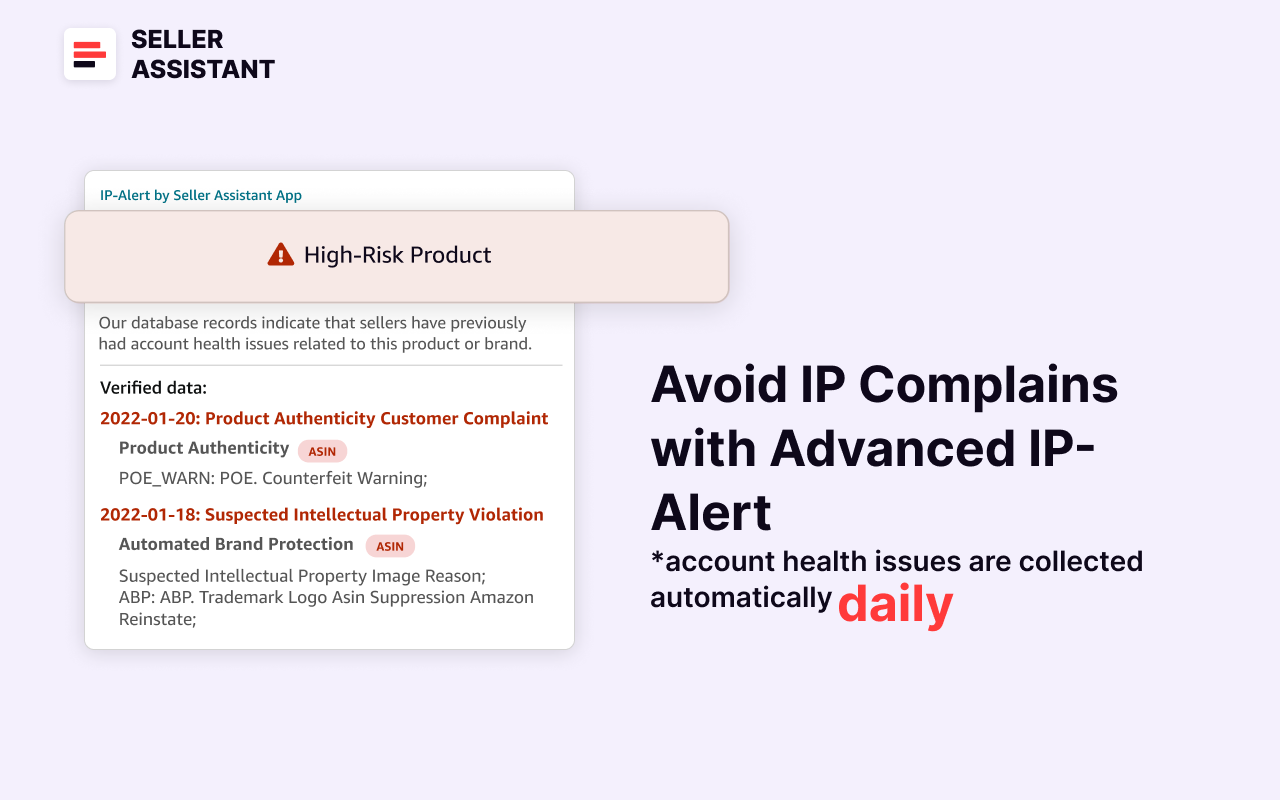
Amazon’s competition
If Amazon sells brand’s products, it can be very difficult to compete for the Buy Box and reduces your selling chances. Amazon’s share is called Amazon In-Stock Rate. A share exceeding 30% suggests high competition. If Amazon sells more than 30% of a brand’s products, it’s better to find another brand to avoid stiff competition.
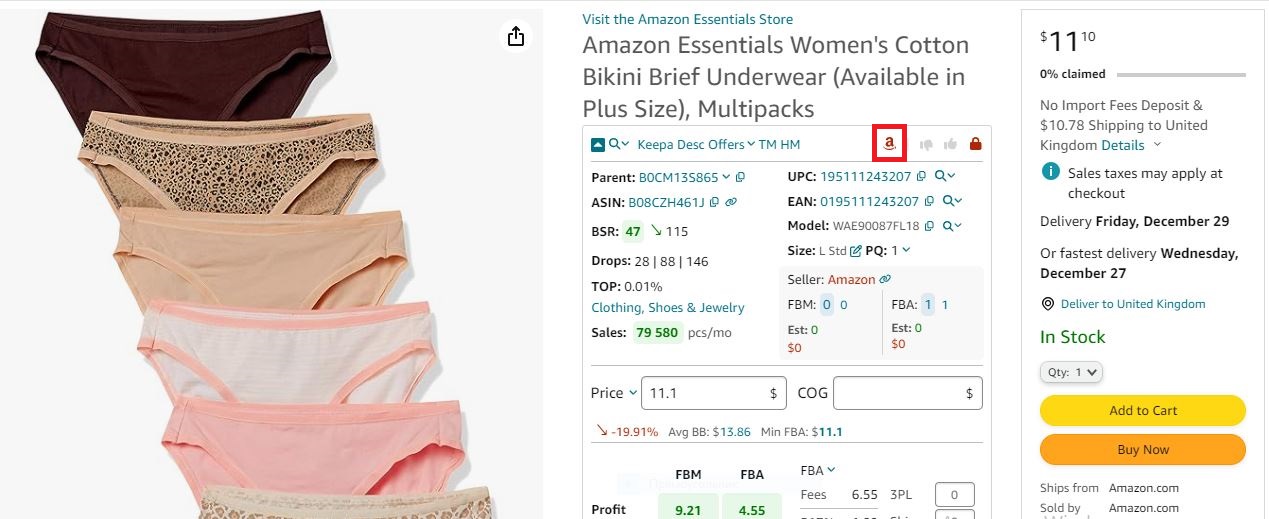
Competition from FBA and FBM sellers
High competition often implies thinner profit margins because sellers often engage in price wars and dump the prices to increase sales. The Average FBA Seller Count for the brand's products shows competition intensity. A count above 15 signifies high competition and potentially thin profit margins.
Brand’s popularity
When you select a brand, you must ensure its products will sell well and it has a good reputation among the customers. You can estimate this by its average rating and review count. The average customer rating of the brand's products reflects customer satisfaction and must be more than 4 stars. The total number of reviews for the brand's products indicates popularity and customer feedback volume. Low number of reviews may mean that a brand is new or has sales issues.
Related: Amazon Account Health – A Guide for FBA Sellers
Amazon Account Health Assurance
What is Amazon Seller Account Health Rating?
How To Avoid Amazon Seller Account Suspension?
How to Automate Brand Research?
Manually analyzing all the above mentioned criteria is extremely time- and effort-consuming. However, you can do brand research automatically with Seller Assistant’s Brand Analyzer.
This Amazon brand research tool helps identify profitable brands and shows all other data to help understand if it’s worth reselling on Amazon.

Brand analyzer shows two data layers: the general data about the brand summarized in the table in your Seller Assistant Personal account, and the breakdown of all brand’s products with detailed information which you can download as an Excel file for further processing.
Brand Analyzer data
Brand summary information
- Brand detailssome text
- The date the brand was uploaded.
- The name of the brand.
- The user who uploaded the brand, adding a layer of transparency.
- Amazon marketplace.
- The number of products offered by the brand.
- Potential revenue some text
- Brand Monthly Revenue Estimation
- Average Selling Price
- Average FBA Fees charged by Amazon for the brand’s products.
- Competition analysissome text
- Amazon In-Stock Rate
- Average FBA Seller Count
- Customer feedback and brand reputationsome text
- Average Rating
- Total Reviews
Product breakdown data
- ASIN;
- Title;
- Brand;
- Category;
- BSR during 30 days;
- Variations yes/no, variation count;
- Amazon In-Stock Rate;
- Total seller count on the listing;
- FBA seller count;
- FBM seller count;
- Buy Box price
- In/out of stock;
- Launch date;
- Rating;
- Review count;
- Estimated monthly revenue.
How to analyze a brand with Brand Analyzer?
To analyze a brand, open your Seller Assistant personal account and access Brand Analyzer. Choose your marketplace, and type in the brand name you want to research. Once the analysis is complete, review the data.

To access the brand’s store on Amazon, click the Amazon “A” icon.

To get a detailed report with all the metrics for each product, click to download the Excel file with the report. If necessary, filter results. Use the filters available in Excel tables to sort products by necessary metrics.

9 Strategies to Find Amazon FBA Wholesale Suppliers
Finding a good wholesale supplier can be challenging and requires time and effort. On average, it takes a couple of months. Also, the success rate with a brand is typically around 20-30%, and of those 25-30% work in terms of product popularity and profitability. Therefore, you must be patient and give it time.
Below you can find some practical strategies that will help you find a supplier for your wholesale business.

Strategy 1. Approach a brand directly
Contact the brand directly and express your interest in buying their products. Discuss your pricing needs and inquire about the Minimum Order Quantity required to get the price you want.
This strategy is best suited for sellers with multiple distribution channels and significant capital, as it often requires an investment of tens of thousands of dollars. As your business grows, you could even become an exclusive or semi-exclusive distributor for the brand.
Strategy 2. Contact brand’s authorized distributors
Visit the brand’s website and look for a list of their authorized distributors. Contact these distributors to discuss becoming a reseller and meet any minimum requirements they may have.
This approach can help you gain access to authentic products without needing to deal directly with the brand and meet the high MOQ requirements.
Strategy 3. Use existing suppliers to find new ones
Suppliers often distribute products for multiple brands. Once you establish a relationship with a supplier, ask them about other brands they distribute or look at the list of brands on their website. This can lead to new opportunities and a diverse product range.
Strategy 4. Leverage supplier relationships to find higher-quality suppliers
Building a good relationship with a supplier can lead to introductions to other high-quality suppliers. Trusted suppliers are more likely to recommend reputable counterparts, ensuring you maintain high standards in your inventory.
Strategy 5. Focus on a niche market
Select a specific, narrow product niche that you are familiar with and that has market potential. Use Google to search for distributors within this niche. By concentrating on a niche, you can become an expert and offer products that cater to specific customer needs.
Strategy 6. Find and partner with local brands
Reach out to small, local brands or distributors, especially if you already resell products from brands in the same area. Start with smaller, family-owned brands, often referred to as "mom-and-pop" brands, as they may be more open to partnerships with new sellers.
Strategy 7. Follow the supplier’s distribution route
Use your connections to find suppliers you are already familiar with. These suppliers might be part of a distribution network you know through previous business dealings or personal connections. Leveraging these relationships can lead to reliable supply channels.
Strategy 8. Research competitors
Analyze what brands and products your successful competitors are selling. Tools like Seller Assistant’s Seller Spy can help you identify these profitable products and brands. Emulate their strategies to find similar success.

Related: Amazon’s Vine Program for Sellers: What Is It? And Is It Worth It?
Building Reputation for Amazon Store — Everything Sellers Need to Know
Seller Spy by Seller Assistant is a competitor analysis tool designed to simplify how you monitor your competition on Amazon. It automates the process of monitoring competitor activity, giving you valuable insights without the manual effort.
Seller Spy automatically tracks your competitors and allows you to estimate what new brands and products they started or stopped selling, and how they price each product. You can use this data to add the same or similar products to your portfolio and adjust prices if necessary.

Related: What Is an ASIN?
How to Create an Amazon Seller Central Account
Strategy 9. Explore wholesale directories
Consult wholesale directories that list a variety of worldwide brands and suppliers. Examples include SaleHoo, Worldwide Brands, and Wholesale Central. These directories can provide a broad range of suppliers across different product categories.
How to Vet Amazon FBA Wholesale Suppliers?
When you find a suitable supplier, it’s crucial to verify this supplier is legitimate and their brands align with your business goals. Below you can find some criteria to understand if a supplier is a good or bad fit.
How to know if a supplier is a good choice?
Below you can find several ways to verify supplier legitimacy and check the legitimacy of their website.

Check if the supplier has a presence on LinkedIn. Look for employee profiles, company updates, and any endorsements. A well-maintained LinkedIn profile indicates a legitimate business.
Whois
Use Whois lookup tools to find out who owns the domain name and how long it has been registered. This information can help verify the supplier's authenticity.
ScamAdviser
Visit ScamAdviser to see if the supplier’s website has any reports of suspicious activity. This platform can provide a trust score based on various risk factors.
About Us website section
Read the ‘About Us’ section on the supplier’s website. A detailed and professional section should include the company’s history, and say if a company is a wholesale reseller or a retailer. Retailer companies are typically not suitable for wholesale.
Contact information and verifiable address
Look for comprehensive contact information, including a phone number, email address, and physical address. Verify the address using Google Maps or other mapping services to ensure it is a real location.
Active social media
Check the supplier’s activity on social media platforms like Facebook, Twitter, and Instagram. Active and regularly updated social media profiles indicate a legitimate and engaged business.
Reviews on Google and review sites
Search for reviews of the supplier on Google and specialized review sites like Trustpilot or the Better Business Bureau. Positive reviews and high ratings suggest a trustworthy supplier.
How to know if a supplier is a bad choice?
Lack of desired brands
Ensure the supplier carries the brands you want to source. If they do not stock the specific brands or types of products you’re interested in, they won’t be a good fit for your business.
Avoiding Fake Suppliers
Supplier doesn't fit your business model
If the supplier’s offerings or brand portfolio do not align with your business model, they may not be the right fit for you. For example, you can’t resell private label brands because they are trademarked, or the supplier may have too high MOQs. Then, it’s best to look elsewhere.
Non-US based suppliers for US market
If you sell primarily in the US, it’s beneficial to work with suppliers based in the US. Non-US suppliers may lead to longer shipping times and higher import duties, complicating your logistics and customer service.
Watch out for red flags
Fake suppliers may have websites that look professional at first glance but lack detailed contact information, have suspiciously low prices, or require upfront payments through unsecured methods. Make sure you carefully review all these data to avoid losing money.
FAQ
Which country is best for FBA wholesale?
The United States is often considered the best country for FBA wholesale due to its large consumer market, efficient logistics, and strong supplier networks. Additionally, sourcing from US-based suppliers can reduce shipping times and import duties for sellers targeting the US market.
How do I find the wholesaler of a product?
To find the wholesaler of a product, start by contacting the product's brand and requesting a list of authorized distributors. Additionally, you can search for wholesale directories, partner with local brands, or research your competitors with Seller Assistant’s Seller Spy.
Can you buy directly from a wholesaler?
Yes, you can buy directly from a wholesaler, which often allows you to purchase products at lower prices compared to retail. To do this, you typically need a reseller's permit and may have to meet the wholesaler's minimum order requirements.
Is Amazon FBA wholesale easy?
Amazon FBA wholesale can be challenging due to the need to find reliable suppliers, manage inventory, and navigate Amazon's regulations and competition. However, with thorough research and effective strategies, it can be a profitable business model.
Final Thoughts
Finding Amazon FBA wholesale suppliers who sell these products for lower price to resell them on Amazon with maximum profit is one of the most challenging tasks of wholesale sellers. You must thoroughly research products to ensure they will generate the expected profit, as you are investing a significant amount of money in them.
The best product sourcing tool to help you with that is Seller Assistant. This all-in-one product research software helps ensure you choose the most profitable wholesale products. It offers all the features vital for bulk product research.
It combines three extensions: Seller Assistant Extension, IP Alert Extension by Seller Assistant, and VPN by Seller Assistant, tools: Price List Analyzer, Brand Analyzer, Seller Spy, Bulk Restrictions Checker, and API integrations, and features: Side Panel View, FBM&FBA Profit Calculator, Quick View, ASIN Grabber, UPC/EAN to ASIN converter, Stock Checker, and other features that help quickly find high-profit deals. Seller Assistant also offers integration with Zapier allowing to create custom product sourcing workflows.

.svg)














